|
|
|
|
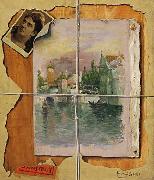 |
John Haberle
|
|
(1856-1933) was a 19th-century American painter in the trompe l'oeil (literally, "fool the eye") style. His still lifes of ordinary objects are painted in such a way that the painting can be mistaken for the objects themselves. He is considered one of the three major figuresetogether with William Harnett and John F. Petoepracticing this form of still life painting in the United States in the last quarter of the 19th century.
Haberle was born in New Haven, Connecticut; his parents were Swiss immigrants. At the age of 14 he left school to apprentice with an engraver. He also worked for many years as an exhibit preparator for the Peabody Museum of Natural History at Yale University. His career as a painter began in 1887.
His style is characterized by a meticulous rendering of two-dimensional objects. He is especially noted for his depictions of paper objects, including currency. Art historian Alfred Frankenstein has contrasted Haberle's work with that of his contemporaries:
Peto is moved by the pathos of used-up things. Haberle is wry and wacky, full of bravado, self-congratulating virtuosity, and sly flamboyance. He works largely within an old tradition, that of the trompe l'oeil still life in painted line ... It is poles away from Harnett's sumptuosity, careful balances, and well-modeled volumes, and is equally far from Peto's sensitivity in matters of tone and hue.
A Bachelor's Drawer (1890-94) is typical of his approach: various papers, including currency, postage stamps, photos, playing cards, tickets, and newspaper clippings, are shown affixed to an essentially planar surface. Other objectseeyeglasses, a comb, a pipe, matches, and so oneare shallow enough in volume so as not to spoil the illusion.
Like Harnett, he was warned by the Secret Service to cease and desist painting paper money, but he continued to do so throughout his years of greatest productivity; examples include The Changes of Time (1888) and Can You Break a Five? (c. 1885). He painted other subjects such as Slate (c. 1895), a bin of peanuts in Fresh Roasted (1887), The Clay Pipe (1889), and the huge Grandma's Hearthstone (1890), in the collection of the Detroit Institute of Arts.
By the turn of the century, problems with his eyes diminished Haberle's activity as an artist. Among his later works are paintings of flowers executed in a looser style, and in 1909 he painted his final trompe l'oeil, the large Night, in the collection of the New Britain Museum of American Art, New Britain, Connecticut. Haberle died in 1933.
|
|
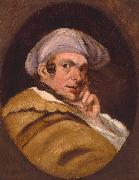 |
John Hamilton Mortimer
|
|
ARA (1740-1779) was a British Neoclassical figure and landscape painter and printmaker, known for romantic paintings set in Italy, works depicting conversations, and works drawn in the 1770s portraying war scenes, similar to those of Salvator Rosa.
Mortimer became President of the Society of Artists in 1774, five years before his death, at age 39.
John Hamilton Mortimer was born on 17 September 1740 at Eastbourne. Not much is known about his family, other than that his father was a customs officer, a dealer in flour and owner of several mills. By 1757, while he was still young, he was studying in London at the Duke of Richmond's Academy. During this time he became a friend of Joseph Wright, a fellow student at the Academy - a friendship which would endure throughout Mortimer's life. Mortimer is also known to have had some professional relationship with the artist Samuel Ireland, who was involved with etching Mortimer's work. At the St Martin's Lane Academy his fellow students included Thomas Jones and William Pars. In 1759 Mortimer won a first prize for a study after Michelangelo's Bacchus and a second prize for a life drawing.
He began to display his works on a regular basis from the early 1760s onwards. He became an active member of the Society of Artists and President of the Society in 1774. |
|
 |
John Hayter
|
|
(1800-1895) was an English portrait painter. He was the second son of the miniaturist Charles Hayter and brother of Sir George Hayter, also a portaitist. He entered the Royal Academy schools in 1815, and began to exhibit at the Royal Academy in the same year. He also exhibited work at the British Institution and the Royal Society of British Artists. Hayter established himself during the 1820s, with portraits of notable figures such as the Duke of Wellington and the opera singer, Giuditta Pasta. His portrait drawings, in chalks or crayons, became particularly popular, a number of them being engraved for The Court Album, Portraits of the female aristocracy (1850-57). |
|
|
|
|
|
 |
John Henry Twachtman
|
|
American Impressionist Painter, 1853-1902
American painter and printmaker. He began as a painter of window-shades but developed one of the most personal and poetic visions in American landscape painting, portraying nature on canvases that were, in the words of Childe Hassam, 'strong, and at the same time delicate even to evasiveness'. His first artistic training was under Frank Duveneck, with whom he studied first in Cincinnati and then in Munich (1875-7). His absorption of the Munich style, characterized by bravura brushwork and dextrous manipulation of pigment, with the lights painted as directly as possible into warm, |
|
|
|
 |
John Hermann Carmiencke
|
|
Johann Hermann Carmiencke or John Hermann Carmiencke (born at Hamburg in 1810; died at Brooklyn, New York on 15 June 1867) was a landscape painter and etcher.
|
|
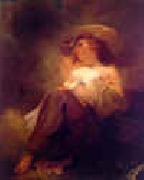 |
John Hoppner
|
|
1758-1810
British
John Hoppner Galleries
John Hoppner (April 4?, 1758 - January 23, 1810), English portrait-painter, was born in Whitechapel.
His father was of German extraction, and his mother was one of the German attendants at the royal palace. Hoppner was consequently brought early under the notice and received the patronage of George III, whose regard for him gave rise to unfounded scandal. As a boy he was a chorister at the royal chapel, but showing strong inclination for art, he in 1775 entered as a student at the Royal Academy. In 1778 he took a silver medal for drawing from the life, and in 1782 the Academy's highest award, the gold medal for historical painting, his subject being King Lear.
He first exhibited at the Royal Academy In 1780. His earliest love was for landscape, but necessity obliged him to turn to the more lucrative business of portrait painting. At once successful, he had throughout life the most fashionable and wealthy sitters, and was the greatest rival of the growing attraction of Lawrence. Ideal subjects were very rarely at tempted by Hoppner, though a "Sleeping Venus," "Belisarius," "Jupiter and Io," a "Bacchante" and "Cupid and Psyche" are mentioned among his works. The prince of Wales visited him especially often, and many of his finest portraits are in the state apartments at St. James's Palace, the best perhaps being those of the prince, the duke and duchess of York, of Lord Rodney and of Lord Nelson, Among his other sitters were Sir Walter Scott, the Duke of Wellington, Frere and Sir George Beaumont.
Competent judges have deemed his most successful works to be his portraits of women and children. A Series of Portraits of Ladies was published by him in 1803, and a volume of translations of Eastern tales into English verse in 1805. The verse is of but mediocre quality. In his later years Hoppner suffered from a chronic disease of the liver. He was confessedly an imitator of Reynolds. When first painted, his works were much admired for the brilliancy and harmony of their colouring, but the injury due to destructive mediums and lapse of time which many of them suffered caused a great depreciation in his reputation. The appearance, however, of some of his pictures in good condition has shown that his fame as a brilliant colourist was well founded. His drawing is faulty, but his touch has qualities of breadth and freedom that give to his paintings a faint reflection of the charm of Reynolds. Hoppner was a man of great social power, and had the knowledge and accomplishments of a man of the world.
The best account of Hoppner's life and paintings is the exhaustive work by William McKay and W Roberts (1909 |
|
|
|
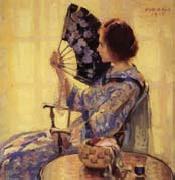 |
John Hubbard Rich
|
|
American,a versatile artist painting portraits, still lifes, figures and florals1878-1955
|
|
|
|
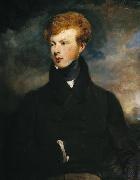 |
John Jackson
|
|
(31 May 1778 - 1 June 1831) was an English painter.
Jackson was born in Lastingham, Yorkshire, and started his career as an apprentice tailor to his father, who opposed the artistic ambitions of his son. However, he enjoyed the support of Henry Phipps, 1st Earl of Mulgrave (1755-1831), who recommended him to the Earl of Carlisle, as well as that of Sir George Beaumont, 7th Baronet - who offered him residence at his own home and ₤50 per annum - and was able to attend the Royal Academy Schools, where he befriended David Wilkie and B. R. Haydon. At Castle Howard, residence of the Earl of Carlisle, he could study and copy from a large collection of paintings. His watercolours were judged to be of uncommon quality. By 1807 his reputation as a portrait painter was assured, and he made the transition to oils steadily, if not easily, regularly forwarding paintings to Somerset House. After a visit to the Netherlands and Flanders with Edmund Phipps in 1816, he accompanied Sir Francis Chantrey on a trip to Switzerland, Rome, Florence and Venice in 1819. In Rome he was elected to the Academy of St Luke. His portrait of Antonio Canova, painted on this trip, was regarded as being outstanding.
Jackson was a prolific portraitist, strongly showing the influence of Sir Thomas Lawrence and Henry Raeburn in his work. His sitters included the Duke of Wellington, the explorer Sir John Franklin and some noted Wesleyan ministers. His 1823 portrait of Lady Dover, wife of George Agar-Ellis, 1st Baron Dover, was widely acclaimed.
He was a Royal Academy student from 9 March 1805, was elected an Associate of the RA on 6 November 1815 and elected a full member on 10 Feb 1817.
John Jackson was married twice - the first marriage was to the daughter of a jeweller, the second to Matilda the daughter of the painter James Ward. He died in St John's Wood, London.
|
|
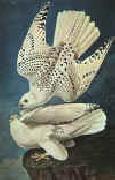 |
John James Audubon
|
|
1785-1851
Audubon, John James ~ Bobwhite (Virginia Partridge), 1825Audubon developed his own methods for drawing birds. First, he killed them using fine shot to prevent them from being torn to pieces. He then used fixed wires to prop them up into a natural position, unlike the common method of many ornithologists of first preparing and stuffing the specimens into a rigid pose. When working on a major specimen, like an eagle, he would spend up to four 15 hour days, preparing, studying, and drawing it.[53] His paintings of birds are set true-to-life in their natural habitat and often caught them in motion, especially feeding or hunting. This was in stark contrast with the stiff representations of birds by his contemporaries, such as Alexander Wilson. He also based his paintings on his own field observations.
He worked primarily with watercolor early on, then added colored chalk or pastel to add softness to feathers, especially those of owls and herons.[54] He would employ multiple layers of watercoloring, and sometimes use gouache. Small species were often drawn to scale, placed on branches with berries, fruit, and flowers, sometimes in flight, and often with many individual birds to present all views of anatomy. Larger birds were often placed in their ground habitat or perching on stumps. At times, as with woodpeckers, he would combine several species on one page to offer contrasting features. Nests and eggs are frequently depicted as well, and occasionally predators, such as snakes. He usually illustrated male and female variations, and sometimes juveniles. In later drawings, he had aides render the habitat for him. Going behind faithful renderings of anatomy, Audubon employed carefully constructed composition, drama, and slightly exaggerated poses to achieve artistic as well as scientific effects. |
|
|
|
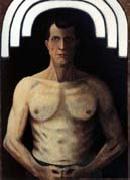 |
John Kane
|
|
1860-1934
American painter of Scottish birth. In 1879 Kane emigrated to western Pennsylvania. He worked as a bricklayer, coal miner, steel worker and carpenter in the Ohio River valley and, in 1890, began to sketch local scenery. After losing his leg in a train accident in 1891, he was employed painting railway carriages. When his son died in 1904, Kane left his family and spent years wandering and working in odd jobs; his earliest surviving paintings date from around 1910. Settling in Pittsburgh, he worked as a house painter and in his spare time painted portraits, religious subjects, the city's urban landscape and memories of his Scottish childhood. In 1927 the jury of the Carnegie International Exhibition, Pittsburgh, encouraged by the painter-juror Andrew Dasburg (b 1887), accepted Kane's Scene in the Scottish Highlands (1927; Pittsburgh, PA, Carnegie Mus. A.). Kane's success, at first considered a hoax by the press, was based on the modernist interest in primitive and folk art. His work was regarded as non-academic and boldly original, and he became the first contemporary American folk artist to be recognized by a museum. Larimer Avenue Bridge (1932; Pittsburgh, PA, Carnegie Mus. A.) is characteristic of his style with its meticulous detail, flat colour and dominant green and red. Though he sketched and painted on the site, Kane freely transposed pictorial elements to create a more pleasing composition. This innate compositional sense is evident in his Self-portrait (1929; New York, MOMA). |
|
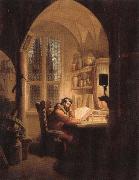 |
john keats
|
|
Born: 31 October 1795
Birthplace: Near London, England
Died: 23 February 1821 (tuberculosis)
Best Known As: Romantic poet who wrote "Ode to a Nightingale"
|
|
|
|
 |
John Kensett
|
|
1816-1872
John Kensett Art Galleries
Artist John Frederick Kensett was born on March 22, 1816 in Cheshire, Connecticut, and died on December 14, 1872 in New York City. He attended school at Cheshire Academy, and studied engraving with his immigrant father, Thomas Kensett, and later with his uncle, Alfred Dagget. He worked as engraver in the New Haven area until about 1838, after which he went to work as a bank note engraver in New York City.
In 1840, along with Asher Durand and John William Casilear, Kensett traveled to Europe in order to study painting. There he met and traveled with Benjamin Champney. The two sketched and painted throughout Europe, refining their talents. During this period, Kensett developed an appreciation and affinity for 17th century Dutch landscape painting. Kensett and Champney returned to the United States in 1847.
After establishing his studio and settling in New York, Kensett traveled extensively throughout the Northeast and the Colorado Rockies as well as making several trips back to Europe.
Kensett is best known for his landscape of upstate New York and New England and seascapes of coastal New Jersey, Long Island and New England. He is most closely associated with the so-called "second generation" of the Hudson River School. Along with Sanford Robinson Gifford, Fitz Hugh Lane, Jasper Francis Cropsey, Martin Johnson Heade and others, the works of the "Luminists," as they came to be known, were characterized by unselfconscious, nearly invisible brushstrokes used to convey the qualities and effects of atmospheric light. It could be considered the spiritual, if not stylistic, cousin to Impressionism. Such spiritualism stemmed from Transcendentalist philosophies of sublime nature and contemplation bringing one closer to a spiritual truth.
In 1851 Kensett painted a monumental canvas of Mount Washington that has become an icon of White Mountain art. Mount Washington from the Valley of Conway was purchased by the American Art Union, made into an engraving by James Smillie, and distributed to 13,000 Art Union subscribers throughout the country. Other artists painted copies of this scene from the print. Currier and Ives published a similar print in about 1860. This single painting by Kensett helped to popularize the White Mountain region of New Hampshire.
Kensett's style evolved gradually, from the traditional Hudson River School manner in the 1850s into the more refined Luminist style in his later years. By the early 1870s Kensett was spending considerable time at his home on Contentment Island, on Long Island Sound near Darien, Connecticut. |
|
|
|
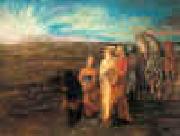 |
John La Farge
|
|
1835-1910
John La Farge (March 31, 1835 ?C November 14, 1910) was an American painter, stained glass window maker, decorator, and writer.
Born in New York City, New York, his interest in art was aroused during his training at Mount St. Mary's University and St. John's College (now Fordham University). He had only the study of law in view until he returned from his first visit to Paris, France where he studied with Thomas Couture and enjoyed the most brilliant literary society of the day. Even his earliest drawings and landscapes, done in Newport, Rhode Island, after his marriage in 1861 to Margaret Mason Perry, sister-in-law of Lilla Cabot Perry, show marked originality, especially in the handling of color values, and also the influence of Japanese art, in the study of which he was a pioneer.
La Farge's inquiring mind led him to experiment with color problems, especially in the medium of stained glass. He succeeded not only in rivaling the gorgeousness of the medieval windows, but in adding new resources by his invention of opalescent glass and his original methods of superimposing and welding his material. Among his many masterpieces are the "Battle Window" at Harvard and the cloisonn?? "Peacock Window" in the Worcester Art Museum. Two of his largest windows are located in Unity Church in North Easton, Massachusetts. The earliest of these, the "Angel of Help" was completed in 1887 while the "Figure of Wisdom" dates to 1901. Both of these windows were restored by "Victor Rothman for Stained Glass Inc" of Yonkers, New York in the 1990's.
Between 1859 and 1870, he illustrated Tennyson's Enoch Arden and Robert Browning's Men and Women. Breadth of observation and structural conception, and a vivid imagination and sense of color are shown by his mural decorations. His first work in mural painting was done in Trinity Church, Boston, in 1873. Then followed his decorations in the Church of the Ascension (the large altarpiece) and St. Paul's Church, New York. For the State Capitol at St. Paul he executed, in his seventy-first year, four great lunettes representing the history of religion, and for the Supreme Court building at Baltimore, a similar series with Justice as the theme. In addition there are his vast numbers of other paintings and water colors, notably those recording his extensive travels in the Orient and South Pacific.
His labors in almost every field of art won for him from the French Government the Cross of the Legion of Honor and membership in the principal artistic societies of America, as well as the presidency of the Society of Mural Painters. Enjoying an extraordinary knowledge of languages (ancient and modern), literature, and art, by his cultured personality and reflective conversation he greatly influenced all who knew him. Though naturally a questioner he venerated the traditions of religious art, and preserved always his Catholic faith and reverence.
In 1904, he was one of the first seven chosen for membership in the American Academy of Arts and Letters. On his passing in 1910, John LaFarge was interred in the Green-Wood Cemetery in Brooklyn, New York. During his life, he maintained a studio at 51 West 10th Street, in Greenwich Village, which today is part of the site of Eugene Lang College |
|
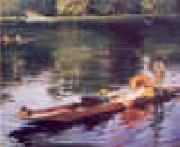 |
John Lavery
|
|
1856-1941
Sir John Lavery (20 March 1856 ?C 10 January 1941) was an Irish painter best known for his portraits.
Belfast-born John Lavery attended the Haldane Academy in Glasgow, Scotland, in the 1870s and the Acad??mie Julian in Paris in the early 1880s. He returned to Glasgow and was associated with the "Glasgow School". In 1888 he was commissioned to paint the state visit of Queen Victoria to the Glasgow International Exhibition. This launched his career as a society painter and he moved to London soon after. In London he became friendly with James McNeill Whistler and was clearly influenced by him.
Like William Orpen, Lavery was appointed an official artist in the First World War. Ill-health, however, prevented him from travelling to the Western Front. A serious car crash during a Zeppelin bombing raid also kept him from fulfilling this role as war artist. He remained in Britain and mostly painted boats, planes and airships. During the war years he was a close friend of the Asquith family and spent time with them at their Sutton Courtenay Thames-side residence, painting their portraits and idyllic pictures like Summer on the River (Hugh Lane Gallery).
After the war he was knighted and in 1921 he was elected to the Royal Academy. During this time, he and his wife both became interested in their Irish heritage and were tangentially involved in both the Irish War of Independence and the Irish Civil War: they gave the use of their London home to the Irish negotiators during the Treaty negotiations. After Michael Collins was killed, Lavery painted Michael Collins, Love of Ireland, now in the Hugh Lane Municipal Gallery.
In 1929 John Lavery made substantial donations of his work to both The Ulster Museum and the Hugh Lane Municipal Gallery and in the 1930s he returned to Ireland. He received honorary degrees from the University of Dublin and Queen's University of Belfast. He was also made a free man of both Dublin and Belfast.
He died in County Kilkenny, aged 84, from natural causes. He was buried in Putney Vale Cemetery. |
|
|
|
|
|
|
|
|
|
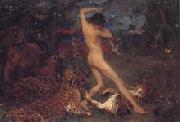 |
John Macallan Swan
|
|
British Academic Painter, 1847-1910
was an English painter and sculptor. John Macallan Swan was born in Brentford, Middlesex in 1847. He received his art training first in England at the Worcester and Lambeth schools of art and the Royal Academy schools, and subsequently in Paris, in the studios of Jean-L??on G??rôme and Emmanuel Fr??miet. He began to exhibit at the Academy in 1878, and was elected associate in 1894 and academician in 1905. He was appointed a member of the Dutch Water-Colour Society in 1885; and associate of the Royal Society of Painters in Water Colours in 1896 and full member in 1899. A master of the oil, water-colour and pastel mediums, an accomplished painter and a skilful draughtsman, he ranks also as a sculptor of distinguished ability. He has treated the human figure with notable power, but it is by his representations of the larger wild animals, mainly the felidae, that he chiefly established his reputation; in this branch of practice he has scarcely a rival. His picture "The Prodigal Son," bought for the Chantrey collection in 1889, is in the National Gallery of British Art. |
|
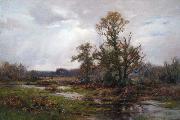 |
John MacWhirter
|
|
(27 March 1839 Slateford, Water of Leith - 28 January 1911 London) was a Scottish landscape painter.
John was the third of four children. He attended a school in Colinton, and after his father's death was apprenticed to Oliver & Boyd, booksellers in Edinburgh. He stayed there for only a few months and then in 1851 enrolled at the Trustees Academy under Robert Scott Lauder and John Ballantyne (1815-97). He spent long periods sketching and studying nature outdoors. His first painting to be exhibited at the Royal Scottish Academy at age 14, was 'Old Cottage at Braid'. In 1880, he was made an Honorary Member of the Royal Scottish Academy. Exploring and painting abroad he visited Italy, Sicily, Switzerland, Austria, Turkey, Norway and the U.S.A. - the Alps being a great inspiration. He moved to London in 1867 and on 4 May 1893 was elected a Royal Academician.
MacWhirter specialised in romantic landscapes with a great fondness for trees, spending much time in the hilly countryside of Perthshire. Initially, under the influence of John Everett Millais, he experimented with the detailed images of the Pre-Raphaelites, but later adopted a more sweeping style. With John Pettie he illustrated The Postman's Bag (Strahan, 1862), and Wordsworth's Poetry for the Young (Strahan, 1863). |
|
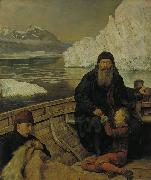 |
John Maler Collier
|
|
(27 January 1850 - 11 April 1934), called 'Jack' by his family and friends, was a leading English artist, and an author. He painted in the Pre-Raphaelite style, and was one of the most prominent portrait painters of his generation. Both his marriages were to daughters of Thomas Henry Huxley. He studied painting at the Munich Academy where he enrolled on 14 April 1875 (Register: 3145) at the age of 25.
Collier was from a talented and successful family. His grandfather, John Collier, was a Quaker merchant who became a Member of Parliament. His father (who was a Member of Parliament, Attorney General and, for many years, a full-time judge of the Privy Council) was created the first Lord Monkswell. He was also a member of the Royal Society of British Artists. John Collier's elder brother, the second Lord Monkswell, was Under-Secretary of State for War and Chairman of the London County Council.
Collier's first wife, Marian Huxley, 1883In due course, Collier became an integral part of the family of Thomas Henry Huxley PC, sometime President of the Royal Society. Collier married two of Huxley's daughters and was "on terms of intimate friendship" with his son, the writer Leonard Huxley. Collier's first wife, in 1879, was Marian (Mady) Huxley. She was a painter who studied, like her husband, at the Slade and exhibited at the Royal Academy and elsewhere. After the birth of their only child, a daughter, she suffered severe post-natal depression and was taken to Paris for treatment where, however, she contracted pneumonia and died in 1887.
In 1889 Collier married Mady's younger sister Ethel Huxley. Until the Deceased Wife's Sister's Marriage Act 1907 such a marriage was not possible in England, so the ceremony took place in Norway. Collier's daughter by his first marriage, Joyce, was a portrait miniaturist, and a member of the Royal Society of Miniature Painters. By his second wife he had a daughter and a son, Sir Laurence Collier KCMG, who was the British Ambassador to Norway 1941-51.
|
|
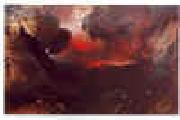 |
John Martin
|
|
British
1789-1854
John Martin Gallery
His first exhibited subject picture, Sadak in Search of the Waters of Oblivion (now in the St. Louis Art Museum), was hung in the Ante-room of the Royal Academy in 1812, and sold for fifty guineas. It was followed by the Expulsion (1813), Paradise (1813), Clytie (1814), and Joshua Commanding the Sun to Stand Still upon Gibeon (1816). In 1821 appeared his Belshazzar's Feast, which excited much favorable and hostile comment, and was awarded a prize of £200 at the British Institution, where the Joshua had previously carried off a premium of £100. Then came the Destruction of Herculaneum (1822), the Creation (1824), the Eve of the Deluge (1841), and a series of other Biblical and imaginative subjects. The Plains of Heaven is thought to reflect his memories of the Allendale of his youth.
Martin's large paintings were inspired by "contemporary dioramas or panoramas, popular entertainments in which large painted cloths were displayed, and animated by the skilful use of artificial light. Martin has often been claimed as a forerunner of the epic cinema, and there is no doubt that the pioneer director D. W. Griffith was aware of his work." In turn, the diorama makers borrowed Martin's work, to the point of plagiarism. A 2000-square-foot version of Belshazzar's Feast was mounted at a facility called the British Diorama in 1833; Martin tried, but failed, to shut down the display with a court order. Another diorama of the same picture was staged in New York City in 1835. These dioramas were tremendous successes with their audiences, but wounded Martin's reputation in the serious art world. |
|
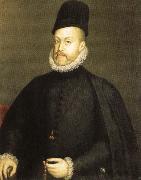 |
john masefield
|
|
(born June 1, 1878, Ledbury, Herefordshire, Eng. ?? died May 12, 1967, near Abingdon, Berkshire) English poet. He went to sea in his youth, then lived precariously for several years in the U.S. before settling in London. He is best known for his poems of the sea, Salt-Water Ballads (1902, including "Sea Fever" and "Cargoes"), and for his long narrative poems, such as The Everlasting Mercy (1911), containing phrases of colloquial coarseness that were unknown in earlier 20th-century English verse. After he became poet laureate in 1930, his poetry became more austere. He also wrote adventure novels, sketches, and works for children.
|
|
|
|
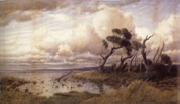 |
John Mather
|
|
Australian painter, etcher and teacher.
1848-1916
|
|
|
|
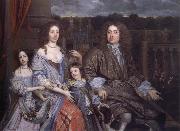 |
John Michael Wright
|
|
English Baroque Era Painter, ca.1617-1694,was a British baroque portrait painter. Wright trained in Edinburgh under the Scots painter George Jamesone, and acquired a considerable reputation as an artist and scholar during a long sojourn in Rome. There he was admitted to the Accademia di San Luca, and was associated with some of the leading artists of his generation. He was engaged by Archduke Leopold Wilhelm of Austria, the governor of the Spanish Netherlands, to acquire artworks in Oliver Cromwell's England in 1655. He took up permanent residence in England from 1656, and served as court painter before and after the English Restoration. A convert to Roman Catholicism, he was a favourite of the restored Stuart court, a client of both Charles II and James II, and was a witness to many of the political manoeuvrings of the era. In the final years of the Stuart monarchy he returned to Rome as part of an embassy to Pope Innocent XI. Wright is currently rated as one of the leading indigenous British painters of his generation and largely for the distinctive realism in his portraiture. Perhaps due to the unusually cosmopolitan nature of his experience, he was favoured by patrons at the highest level of society in an age in which foreign artists were usually preferred. Wright's paintings of royalty and aristocracy are included amongst the collections of many leading galleries today. |
|
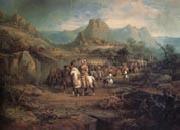 |
John Mix Stanley
|
|
A famous painter of Indians and Indian scen .
American , 1814-1872
American , 1814-1872,was an American painter of landscapes, portraits and Native American life. He was born in Canandaigua, New York and orphaned at the age of 12. At age 14, Stanley became an apprentice to a coach maker. Looking for better work, he moved to west in 1832 and became a painter of signs and portraits. In spring 1843 Stanley accompanied the party of Indian agent Pierce M. Butler to the Tehuacana Creek Council. At the outbreak of the Mexican War in 1845, John Mix Stanley joined Colonel Stephen Watts Kearney's expedition to California and produced many sketches and paintings of the campaign. He traveled to Hawaii in 1848 and spent a year painting portraits of members of the royal family. He traveled across the Isthmus of Panama in 1853. He also painted Comanche warriors in their natural environment. He moved to Detroit in 1864 and remained there for the rest of his life. Stanley helped to found a forerunner of the Detroit Institute of Arts and to incorporate the National Gallery and School of Arts. Stanley's primary interests and sympathies were with the Indians. The Smithsonian exhibited his pictures, but Congress never appropriated monies for them. More than 200 of his works were destroyed in the Smithsonian fire of 1865. |
|
|
|
|
|
|
|
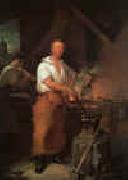 |
John Neagle
|
|
1796-1860
John Neagle Gallery
Neagle's training in art began with instruction from the drawing-master Pietro Ancora and an apprenticeship to Thomas Wilson, a well-connected painter of signs and coaches in Philadelphia. Wilson introduced him to the painters Bass Otis and Thomas Sully, and Neagle became a protege of the latter. In 1818 Neagle decided to concentrate exclusively on portraits, setting up shop as an independent master.
Aside from brief sojourns in Lexington, Kentucky, and New Orleans, Louisiana, he spent his career in Philadelphia. In May 1826 he married Sully's stepdaughter Mary, and for a time the son-in-law and father-in-law dominated the field of portraiture in the city. Neagle served as Director of the Pennsylvania Academy of Fine Arts, and was also a founder and president (1835-43) of the Artist's Fund Society of Philadelphia. |
|
|
|
|
|
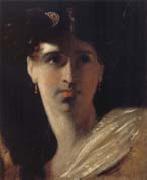 |
John Opie
|
|
English Painter, 1761-1807,English painter. He was born in a tin-mining district, where his father was a mine carpenter. He had a natural talent for drawing and was taken up by an itinerant doctor, John Wolcot (the poet Peter Pindar, 1738-1819), who was an amateur artist and had a number of well-connected friends. Wolcot taught Opie the rudiments of drawing and painting, providing engravings for him to copy and gaining him access to country-house collections. Opie's early portraits, such as Dolly Pentreath (1777; St Michael's Mount, Cornwall, Lord St Levan priv. col.), are the work of a competent provincial painter and owe much to his study of engravings after portraits by Rembrandt. His attempts at chiaroscuro and impasto in Rembrandt's manner gave his pictures a maturity that clearly startled contemporary audiences expecting to see works by an untutored artist. Thus in 1780, when a picture by him was exhibited in London at the Society of Artists with the description 'a Boy's Head, an Instance of Genius, not having ever seen a picture', Opie was hailed as 'the Cornish Wonder'. When he himself arrived in London, where he was promoted by Wolcot and his paintings were exhibited at the Royal Academy in 1781 and 1782, he was seen as a phenomenon, impressing even Joshua Reynolds, who is reputed to have remarked that Opie was 'like Caravaggio and Velasquez in one'. |
|
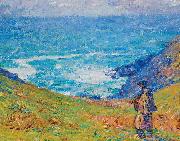 |
John Peter Russell
|
|
(16 June 1858 -22 April 1930) was an Australian impressionist painter.
John Peter Russell was born at the Sydney suburb of Darlinghurst, the eldest of four children of John Russell, a Scottish engineer, his wife Charlotte Elizabeth, nee Nicholl, from London. J. P. Russell was a nephew of Sir Peter Nicol Russell. After his father's death J. P. Russell enrolled at the Slade School of Fine Art, University College, London, on 5 January 1881 and studied under Alphonse Legros for three years.Russell then went to Paris to study painting under Fernand Cormon. (His fellow students there included Henri de Toulouse-Lautrec and Émile Bernard.) Russell was a man of means and having married a beautiful Italian, Mariana Antoinetta Matiocco, he settled at Belle Île off the coast of Brittany, where he established an artists' colony. He would have 11 children with Matiocco, of whom six survived.
John Peter Russell: Vincent van Gogh, 1886, Van Gogh Museum, AmsterdamRussell had met Vincent van Gogh in Paris and formed a friendship with him. Van Gogh spoke highly of Russell's work, and after his first summer in Arles in 1888 he sent twelve drawings of his paintings to Russell, to inform him about the progress of his work. Claude Monet often worked with Russell at Belle Île and influenced his style, though it has been said that Monet preferred some of Russell's Belle Île seascapes to his own. |
|
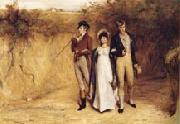 |
John Pettie
|
|
British Painter, 1839-1893
He was brought up in Edinburgh and East Lothian, and in 1855 he entered the schools of the Trustees' Academy, Edinburgh, sponsored by the history painter James Drummond (1816-77). He studied under Robert Scott Lauder, and among his fellow students were WILLIAM QUILLER ORCHARDSON, Thomas Graham (1840-1906), George Paul Chalmers (1833-78), John Burr (1831-93) and John MacWhirter, several of whom later became part of Pettie's circle of Scottish artist friends in London. Pettie first exhibited at the Royal Scottish Academy in 1858 with In Trabois House (untraced), a scene from Sir Walter Scott's The Fortunes of Nigel, and he began sending work to the Royal Academy in 1860. From 1858 he provided illustrations for the periodical Good Words, and, encouraged by the reviews received for his early Royal Academy exhibits, such as The Armourers (exh. RA 1860) and What D'Ye Lack' (exh. RA 1861), when Good Words transferred its headquarters, Pettie moved to London in 1862. He shared a studio in Fitzroy Square with Orchardson and Graham from 1863 until his marriage to Elizabeth Ann Bossom on 25 August 1865. He subsequently lived at various addresses, gravitating towards the wealthy artistic colony in St John's Wood, where in 1882, at 2 Fitzjohn's Avenue, he built a neo-Georgian house and studio, The Lothians (destr.). This reflected not only the professional circle in which Pettie moved but also the rapid financial success that he achieved in London. From the mid-1860s his most important patron was John Newton Mappin, founder of the Mappin Art Gallery, |
|
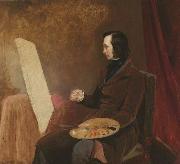 |
John Phillip
|
|
(April 19, 1817-1867) was a Victorian era painter best known for his portrayals of Spanish life. He was nicknamed "Spanish Phillip".
Born into a poor family in Aberdeen in Scotland, Phillip's artistic talent was recognised at an early age. His education at the Royal Academy of Arts was paid for by a wealthy patron. While at the academy Phillip became a member of The Clique a group of aspirant artists organised by Richard Dadd. The Clique considered themselves to be followers of Hogarth and Wilkie. Phillip's own career was to follow that of fellow-Scot Wilkie very closely, beginning with carefully detailed paintings depicting the lives of Scottish crofters, and moving on to much more broadly painted scenes of Spanish life influenced by Murillo and Velezquez.
Phillip's early works tended to depict pious Scots families, but in 1851, after he was advised to travel to southern Europe for his health he visited Spain. Thereafter he concentrated on Spanish subjects. The first of these, The Letter Writer, Seville indicated the influence of Pre-Raphaelitism, a movement he had previously opposed, along with most other members of The Clique, despite his friendship with Millais, one of its leaders. He was so influenced by his travels that he advised other artists to do the same. Some artists, such as Edwin Long, took this advice and were similarly inspired.
In the late 1850s and 1860s Phillip's style became much broader and more painterly, in line with Millais's late work. Phillip's two most important paintings in these years were The Early Career of Murillo (1864) and La Gloria (1865, National Gallery of Scotland). The first depicted the young Murillo drawing his art from Spanish street-life; the second portrayed a Spanish wake for a dead child.
Phillip married Richard Dadd's sister, but like her brother she became insane. Phillip died of a stroke while visiting William Powell Frith. Phillip's self-portrait, "The Evil Eye", commissioned by his close friend Patrick Allan-Fraser, is in Hospitalfield House in Arbroath along with portraits of other members of The Clique.
|
|
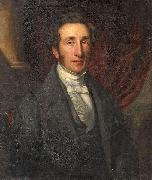 |
John Ponsford
|
|
(1790- 1870 )
painted Portrait of a gentleman. Signed and dated Ponsford 1842 |
|
|
|
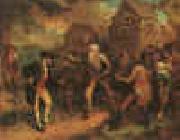 |
John Quidor
|
|
1801-1888
Quidor was born in Gloucester Co., N. J., and in 1826 moved to New York City where he studied painting under John Wesley Jarvis and Henry Inman. Afterward he lived on a farm near Quincy, Illinois, but returned to New York City in 1851. He was obliged to support himself by painting the panels of stage coaches and fire engines and died in abject poverty.
Although Quidor was little appreciated in his own time, after his death he was accorded a place among the best early American artists. His paintings establish a mysterious romantic setting for scenes in which he mingled macabre elements with an earthy humor. Many of his works, such as Ichabod Crane Pursued by the Headless Horseman, in the Smithsonian American Art Museum, were inspired by the writings of Washington Irving, who was a personal friend. Irving's A History of New York gave Quidor the subjects for the four paintings in the Brooklyn (N. Y.) Institute: Dancing on the Battery (c. 1860), Peter Stuyvesant's Wall Street Gate (1864), Voyage of the Good Oloff up the Hudson (1866), and The Voyage from Communipaw to Hell Gate (1866). These show Quidor's characteristic mellow and harmonious color, poetic imagination, and naïve humor.
He is represented in the Brooklyn Museum by three paintings: Dorothea, Money Diggers, and Wolfert's Will. He also painted religious subjects such as Jesus Blessing the Sick. |
|
|

